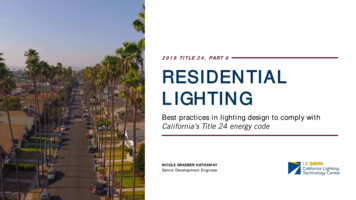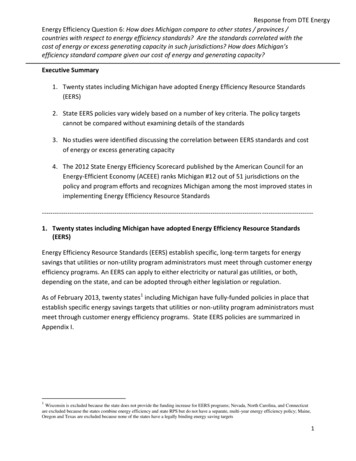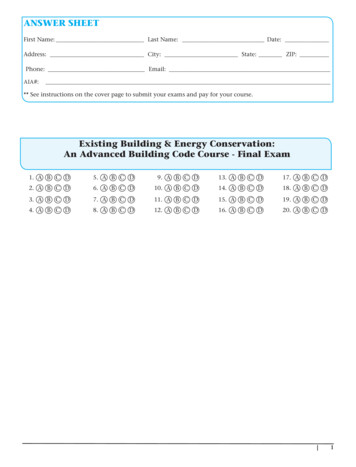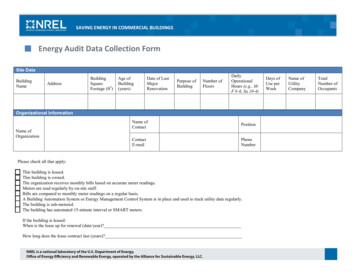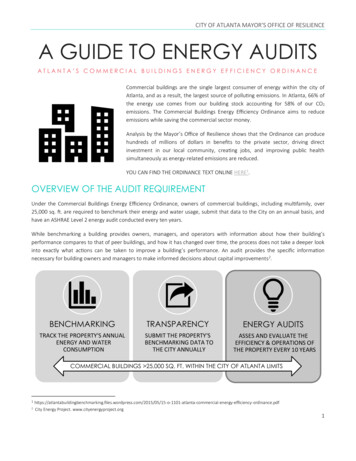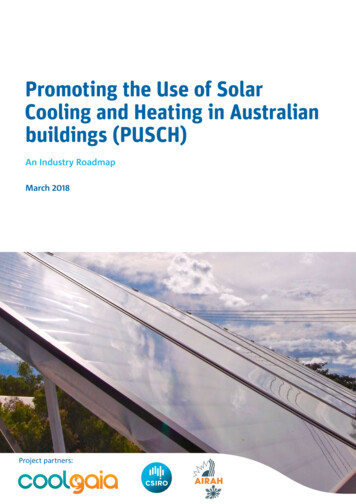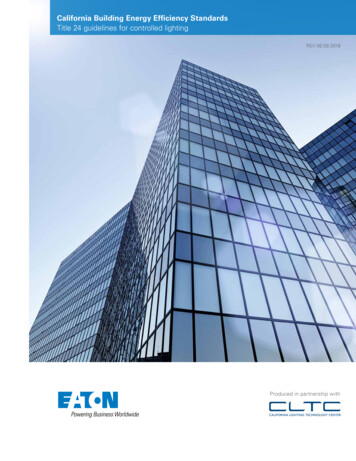
Transcription
California Building Energy Efficiency StandardsTitle 24 guidelines for controlled lightingREV 06.09.2016Produced in partnership with
Title 24 Guidelines for Controlled LightingEATONTitle 24 Guidelines
Title 24 Guidelines for Controlled LightingOn July 1, 2014, California Title 24 (T24) Building Energy Efficiency Standards went into effect. The lighting andlighting controls sections were expanded clarifying the mandatory requirements for residential and nonresidentialbuildings that include outdoor spaces. In keeping with the California legislation, the standards must be cost effectiveand include approaches that account for equipment improvements in efficient technology. As one will see, the newertechnologies delivering higher energy savings are favored in the code. The new efficiency standards focus on lightingcontrols and LED luminaires, both of which offer the greatest energy savings with control capabilities.California Energy Commission estimated reduction benefits from code compliance:Annual energy savingsResulting air quality and emission reductions per year 613 gigawatt-hours 215 metric tons carbon dioxide equivalent 195 megawatts peak demand 2.4 tons sulfur oxides 41 tons carbon monoxide 59 tons nitric oxideTABLE OF CONTENTSHow to use this guide4NONRESIDENTIAL OUTDOOR APPLICATIONS38Iconography5Pole Mounted Luminaires40General Education on Title 2410Non-Pole Mounted Luminaires41NONRESIDENTIAL INDOOR APPLICATIONS12Sales Luminaires42Small Office14Building Façade and Outdoor Dining43Medium or Large Office15Loading Docks44Corridor, Hall and Stairwell16General Parking Lots and Hardscapes45Conference Room17Nonresidential Outdoor Controls (LumaWatt)46Entry, Waiting and Lobby18Nonresidential Outdoor Lighting Products48Restaurant and Dining19RESIDENTIAL APPLICATIONSRestroom - Single Stall20Single Family Home5052Restroom - Multi-Stall21Multi-Family Home53Parking Garage22High-Rise Home54Cafeteria, Multipurpose and Gym23Dormitory55Classroom24Senior Living Quarters56Electrical Mechanical Room25Hotel/Motel Guest Rooms57Library Stacks26Halo and Title 24 Residential Standards58Library Open Area27Residential Products - High Efficacy60Warehouse Industrial Open Area28Residential Products - Low Efficacy62Warehouse Racks29APPENDIXIntegrated Sensor System30Interior Quick Reference Guide64Nonresidential Indoor Room Controller System 32Interior Quick Reference Guide Key65Nonresidential Indoor Lighting Products34Multi-Level Requirements Guide66Nonresidential Indoor Ambient Products35Exterior Quick Reference Guide and Key67Lighting Power Density Tables68Nonresidential Indoor Exit and Egress Products 36Nonresidential Indoor Control Products37While this training material was developed based upon the published Building Energy Efficiency Standards for Residential and NonresidentialBuildings (CEC-400-201-004-CMF-REV2), Residential Compliance Manual for the 2013 Building Energy Efficiency Standards (CEC-400-2013-001CMF), and Nonresidential Compliance Manual for Building Energy Efficiency Standards (CEC-400-2013-002-CMF) (collectively, “the code”); it is notintended to replace the code and experts that interpret the code. This training material is based on the code as it exists at the time of publication, andthe code may be updated without notice. Eaton accepts no liability for the content of this presentation, or the consequences of any action taken onthe basis of the information provided.EATONTitle 24 Guidelines (2013 Standards)3
HOW TO USE THIS GUIDEThis guide is constructed to simplify the aggressive and complex California Energy Code of Title 24 into three basic steps coveringthe requirements for the most common spaces found in both Residential and Nonresidential compliance. Icons are used to describethe luminaire and control requirements that are conveniently aligned with Eaton’s broad range of luminaires and controls delivering acompliant Title 24 space.Sample page from this guidebook shown below:Identify Your SpaceSimplification begins by separating a buildinginto spaces such as “office” and outlining theconditions of the space to walk through Title 24requirements. Space assumptions and energybudget requirements are located in the header areawhile the rest of the page details specific luminaireand control combinations to make the space Title24 compliant.Title 24 RequirementsNONRESIDENTIAL INDOOR: Medium or Large OfficeSPACE ASSUMPTIONS Space – Greater than 250 square feet Electrical Load – Greater than 0.5watts per square feet planned Daylighting – Contains skylights orglazing larger than 24 square feet totalrequiring automatic daylighting controlsfor both primary and secondary sidelitzones Building – When cumulative permittedwork area is larger than 10,000 squarefeet Demand Response is required(capable of lowering lighting power by15%). Reference: See 130.1(e) page 144Lighting Power Density 0.75 watts per square feet required for Area Category MethodFor Building Method requirements see table on page 68.Follow the 3 steps below to ensureyour space meets Title 24:SPACE LEVEL (AREA CONTROL) Must be accessible to occupants to operatethe lightingReference:See 130.1(a)page 140Exception when space level control not required: Up to 0.2 W/sf of egress area may becontinuously illuminated and the control is notaccessible to unauthorized personnel1. AnalyzeManually SwitchedON/OFFMULTI-LEVEL LIGHTINGFour simple mandatory lighting control elementscover the changing components of Title 24. Thespace defined above is analyzed against thecode, notes are provided, and exceptions to thespaces are shown. The far right shows the codereferences to facilitate further understanding. Luminaire must provide uniform dimming Capable of reducing power by at least one offour control functions Manual dimmer is required when a dimmingluminaire is present. All other controls areoptional.Icons are presented to visually align the specificrequirements that satisfy Title 24 requirements.The code may offer options or combined functionsto satisfy the requirements.LumenTuning Daylighting DemandMaintenance Control Control ResponseControl(OPTIONAL)SHUTOFF CONTROL Luminaires turned off when vacant 120V receptacles only having one controlledreceptacle within 6 ft of uncontrolled receptacle Separate shut-off control for each 5,000 sq ft Automatic Time Switch control must have andoverride to remain on no more than 2 hoursExceptions to shutoff control include: Lighting serving a continuous use area Emergency egress up to 0.05 watts per sq ft2. AlignManualDimmerOccupancy Manual On/Auto OffSensorRemote Signal AutomaticControlTime SwitchEaton offers a broad range of controlled lighting solutions to satisfy the latestin Title 24 code compliance that are both certified to the California Title 20Appliance database when required and when certification is not required.Note: Title 20 certified products can be found lianceSearch.aspx4EATONTitle 24 Guidelines (2013 Standards)ReceptacleControlReference:See 130.1(c)page 141,130.5(d) pages151-152(CHOOSE ONE OR MORE)AUTOMATIC DAYLIGHTING CONTROL Eliminate energy waste when natural lightpresentExceptions when daylighting control not required: Areas with no skylights or glazing 24 squarefeet; Daylit zone is less than 120WReference:See 130.1(d)page 143LuminaireDimmingDaylightingControlEATON3. Select ProductsThe final step is selecting products that align withthe requirements. The California Title 20 ApplianceDatabase provides a list of certified products forselect product categories such as self-containeddimmers, Metal Halide luminaires, emergencyEXIT signs, residential LED luminaires, etc. Not allproducts must be certified.Reference:See 130.1(a & b)page 140Select appropriate productsolutions from the ProductReference Guides locatedafter the Nonresidentialand Residential sections.References providespecific page numbers tothe code specificationsfound in the CaliforniaEnergy CommissionBuilding Energy EfficiencyStandards. This 245 pagedocument can be found atwww.energy.ca.gov/title24Title 24 Guidelines15
TITLE 24 ICONOGRAPHYIconography SystemThe icons symbolize specific language found in the code requirements. They represent product and space characteristics. Icons not only representthe requirements but attributes Eaton products provide. This simplifies educating one on the code, how to apply the code for a given space, andselect the products that will deliver a Title 24 compliant space.LUMINAIRES / CONTROLSLuminaire DimmingFluorescent Luminairew/ BallastLEDLuminaireResidential RecessedLuminaires w/ BallastEmergency Back-up(For Egress)HighEfficacyMetal HalideLuminaireExitLuminaireFUNCTIONAL REQUIREMENTSDaylightingControlVacancy SensorManual On/Auto OffOccupancy SensorDemandResponseManually SwitchedON/OFFManualDimmerLumen MaintenanceControlTuningControlAutomaticTime Switch (Indoor)AstronomicalTime Switch (Outdoor)PhotocontrolRemote SignalControlCaptive Key-CardControlCombined HVAC &Lighting ControlPart-night OutdoorLighting ic CountdownTimer SwitchSquare FootageRangeMaximum WattageControlled TogetherDaylight OpeningBUG / Zonal LumenRequirementsHeight of Luminairefor Outdoor24/7OperationCONSTRAINTSEATONLighting PowerDensityTitle 24 Guidelines (2013 Standards)5
ICONOGRAPHY GUIDE: Luminaires and ControlsHigh EfficacyLED LuminaireFor the purpose of Title 24 compliance in residential projects a luminairecan be certified as High Efficacy by meeting performance requirements.High efficacy luminaires differ by technology. Some examples are: LEDluminaries must meet Joint Appendix 8 (JA8) and certified to CaliforniaTitle 20 Appliance Database, CFL residential recessed luminaries mustcontain CFL ballast that are certified to California Title 20 ApplianceDatabase meeting select efficacy requirement, and residentialfluorescent luminaires containing fluorescent ballasts that are certifiedto California Title 20 Appliance Database.In order for residential LED luminaires to be classified as High Efficacythey must meet Joint Appendix 8 (JA8) and be certified to the CaliforniaTitle 20 Appliance Database. Residential compliance includes singlefamily homes, hotel/motel guest rooms, high-rise apartment livingspaces, dormitory rooms, senior living facility quarters, etc.; all of whichare considered generically “dwelling” spaces.References: Tables 150.0-A and 150.0-B; Section 150.0(k), 150.2(b),110.9(e), 100.0(h)References: Tables 150.0-A, 150.0-B; Sections 100.0(h), 110.9(e),110.10(b), 130.1(c), 150.0(k), 150.2(b), 110.9(f)Fluorescent Luminairew/ BallastResidential RecessedLuminaires w/ BallastIn Title 24 Residential and Nonresidential compliance, fluorescentluminaires must include ballasts that are certified to the California Title20 Appliance Database. While 4-pin electronic fluorescent is generallyviewed as a compliant device, the ballast installed must be certified tothe California Title 20 Appliance Database. In order to be certified, theballast must meet all Title 20 requirements.Fluorescent ballasts certified to the California Title 20 ApplianceDatabase for use within a residential recessed luminaire would beclassified as High Efficacy. Requirements to use high-efficacy devicesare found in single family homes, hotel/motel guest rooms, high-riseapartment living spaces, dormitory rooms, senior living facility quarters,etc.; all of which are considered “dwellings”.References: Tables 130.1-A, 150.0-A; Sections 100.0(h), 110.1References: Table 150.0-A, 150.0-B; Sections 100.0(h), 110.1, 110.9(f)Luminaire DimmingExitLuminaireTitle 24 Nonresidential indoor compliances utilize dimming luminairesfor requirements such as demand response, multi-level dimmingand daylighting. Power adjustment factors that lower claimed LPDlevels can be earned when select controls strategies are applied.Nonresidential outdoor compliance strategies utilize dimmingluminaires during periods where the area is vacant. Part-night lightingcontrol and centralized time-based zone control may also includedimming as part of an energy use reduction plan.References: Tables 130.1-A and 140.6-A; Sections 130.1(b), 130.1(c),130.1(d), 130.1(e), 130.2(c), 140.6(a)(2)Emergency Back-up(For Egress)Emergency back-up circuits are commonly used in the design of lifesafety systems such as lighting to meet the code requirements forsafety and noted in Title 24 as low power consumption circuits shownon the design plans.References: Sections 130.1(a), 130.1(c), 140.6(a), 140.6(c), 150.0(k)6EATONTitle 24 Guidelines (2013 Standards)Only Emergency Exits luminaires certified to the California Title 20Appliance Database can be used for Title 24 compliance. This doesnot include egress luminaires but those that provide egress signagesuch as “EXIT”, illuminated 24 hours a day and 365 days a year.References: Sections 140.6(a), 140.8(b)
ICONOGRAPHY GUIDE: Functional RequirementsReportingMonitoringFor use in commissioning, reports can be provided from the energymanagement system to demonstrate performance for lighting loads,electrical distribution system results, branch circuit measurements,control impact, demand response, daylighting performance, and showwhere adjustments were made. The ability to report results fromcommissioning are required for building owner for buildings over 10,000square feet.An Energy Management Systems (EMS) is a computerized controlsystem designed to regulate the energy consumption of a building bycontrolling the operation of energy consuming systems, such as theheating, ventilation and air conditioning (HVAC), lighting, and waterheating systems, and is capable of monitoring environmental andsystem loads, and adjusting HVAC operations in order to optimizeenergy usage and respond to demand response signals.Reference: Sections 120.8(a), 120.8(i), 130.1(d), 130.1(e)Reference: Sections 120.8(a), 120.8(i)Vacancy SensorManual On/Auto OffDaylightingControlA manual ON with automatic off control, commonly called “vacancysensors”, can be used to in lieu of occupancy sensors especiallywhen short periods of occupancy occur and the lighting is not neededfor the short period. Title 24 limits the amount of time a space is litwhen a space is not occupied and requires in spaces like offices andconference rooms mandatory controls to turn off a the space whenunoccupied.Title 24 in Nonresidential Indoor compliance mandates daylightingcontrols where there are skylit and sidelit zones. In the case of sidelitzones, where there are 24 square feet of glazing inside buildings and 36square feet of openings or glazing for parking garages. Sidelit zones areseparated in primary and secondary zones. Self-contained sensors mustbe certified to California Title 20 Appliance Database while daylightingsystems must be certified by approved technicians.References: Sections 110.9(a), 110.9(b), 110.10(b), 141.0(b), 150.0(k)References: Tables 141.0-E, 141.0-F; Sections 110.9(a), 110.9(b),130.1(b), 130.1(d), 140.3(c), 140.6(d)DemandResponseOccupancySensorTitle 24 requires that buildings larger than 10,000 square feet havedemand responsive lighting controls capable of delivering a minimumof 15% reduction in lighting load in a uniform method. In the case ofaltered or remodeled spaces, the 10,000 square feet applies to the areamodified.The automatic on and off feature of the occupancy sensor adjusts thelighting load based upon the space’s activity. Title 24 code deploys thisfunctionality as mandatory reducing or turning off power in residential,nonresidential indoor and outdoor compliance requirements. It is alsoincluded to as a power adjustment factor to reduce installed lightingloads to meet the lighting power budgets.References: Tables 130.1-A, 140.6-A, 141.0-E, 141.0-F; Sections110.9(a), 110.10(b), 130.1(b), 130.1(e), 130.3(a), 140.6(a), 141.0(b),References: Tables 140.6-A, 141.0-E, 141.0-F; Sections 110.9(a),110.9(b), 130.1(c), 130.2(c), 130.5(d), 140.6(a), 141.0(b), 150.0(k)ManualDimmerManually SwitchedON/OFFIn nonresidential compliance, continuous dimming is required for certainluminaires such as LED, see TABLE 130.1-A; a manual dimmer is onemethod to satisfy requirements of 130.1(b). Manual dimmers are alsoa part of the power adjustment factor(PAF) offering that can reduceprescriptive lighting power densities(LPD). Residential complianceutilizes dimmers in some spaces when “low efficacy” luminaires areallowed.Title 24 requires that a manual switch control with ON/OFF be providedfor each area enclosed by ceiling-height partitions. There are someexceptions including large areas including malls, sales floors, industrialfacilities, and larger public restrooms. The manual switch must beaccessible within the same room and lighting types such as generallighting and display lighting must be separately circuited. When otherlighting controls are included such as a manual dimmer, the ON/OFFfunctionality cannot be bypassed.References: Tables 130.1-A, 140.6-A, 141.0-E, 141.0-F; Sections110.9(b), 130.1(a), 130.1(b), 130.3(a), 140.6(a), 141.0(b), 150.0(k)References: Tables 141.0-E, 141.0-F; Sections 110.9(a), 110.9(b),130.1(a), 130.1(b), 130.1(c), 141.0(b), 150.0(k)EATONTitle 24 Guidelines (2013 Standards)7
ICONOGRAPHY GUIDE: Functional Requirements (continued)LumenMaintenance ControlTuningControlLumen maintenance provides an initial lower power level by theluminaire corresponding to typical lumen depreciation factor. Thepower will increase over time up to the maximum rated wattage toaccommodate the reduction in the light over time in the space. Lumenmaintenance controls is one of the five function alternatives to meetMulti-level Lighting Controls requirements.Tuning control provides an initial lower power level (controlled byauthorized personnel only). The power can be increased over time up tothe maximum rated wattage. Tuning controls is one of the five functionalternatives to meet Multi-level Lighting Controls requirements.References: Sections 130.1(b)References: Section 130.1(b)ReceptacleControlAutomatic Time Switch(Indoor)Under Title 24, electrical distribution systems deployed with 120Vreceptacles used in offices, lobbies, conference rooms, office spacekitchenettes, copy rooms, hotel/motel guest rooms are required by Title24 to automatically shut-OFF when space is considered unoccupied.They are required to be located six feet from an uncontrolled receptacle.Split wired duplex receptacles with one controlled are acceptable.Title 24 allows for an Automatic Time Switch that controls lightingbased on the time of day and astronomical events such as sunset andsunrise, accounting for geographic location and calendar date to as oneof the shutoff control functions to meet the requirements. Outdoorapplications require the Automatic Time Switch to include Astronomicalfunctionality.References: Sections 110.10(b), 130.5(d), 141.0(b)References: Sections 110.9(a), 110.9(b), 130.1(c), 130.2(c), 130.3(a)Captive Key-CardControlAutomatic CountdownTimer SwitchCombined HVAC &Lighting ControlTitle 24 allows the use of captive key-cards as one of the optionalcontrols to automatically turn off the lighting and controlled receptaclesand/or modify the HVAC setpoints reducing energy consumption uponvacancy. These are commonly used in hotel/motels control in whichthe key that activates the override cannot be released when the lightsare in the on position.Astronomical Time Switch(Outdoor)In Title 24 the use of a countdown timer switch control is limited tosingle-stall restrooms and closets less than 70 square feet with amaximum setting of 10 minutes or in server aisles in server rooms witha maximum setting of 30 minutes.References: Sections 130.1(c)References: Sections 120.2(e), 130.1(c), and 130.5(d)PhotocontrolCommon control device that senses sunlightand turn on the luminaires at dusk and turnsoff the luminaires upon sunrise.References: Section 130.2(c), 130.3(a),150.0(k)8EATONPart-night OutdoorLighting ControlRemoteSignal ControlThese controls turn off or reduce thelighting power for a portion of the night inoutdoor lighting applications such as autodealerships and building facades.Title 24 allows for a signal from anotherbuilding system such as an EnergyManagement System (EMS) or BuildingAutomation System (BAS) as one of theshutoff control functions.References: Sections 110.9(a) , 110.9(b),130.2(c)Title 24 Guidelines (2013 Standards)References: Sections 130.1(c)
ICONOGRAPHY GUIDE: ConstraintsLighting PowerDensitySquare FootageRangeIn nonresidential compliance, once mandatory requirements aresatisfied, lighting power density(LPD) allowances must be satisfied.The evaluation can be done through one of three ways; Prescriptive,Performance or Tailored. Prescriptive is the simplest and can be done atthe building or space level. Be aware that the luminaries power can bereduced by a power adjustment factor (PAF) when coupled with certaincontrols that are not part of the Mandatory Requirements. The TailoredMethod uses target illuminance values and calculated based upon thecavity ratio to determine LPD for general lighting and allows for additionalallowances for ornamental, wall display, etc. The Performance Methodcombines measures based upon Time Dependent Valuation (TDV).Title 24 utilizes the area of a space to determine when to applythe mandatory requirements. Some examples include office size,controlled space, cumulative permitted work area for DemandResponse, etc.References: Tables 140.6-A, 140.6-B, 140.6-C, 140.6-G; Sections130.1(d), 130.1(e), 140.3(c), 140.6(a), 140.6(b), 140.6(c),Daylight OpeningTitle 24 uses the total opening area in square feet within a buildingand parking structure determine the need for daylighting controls. Theopening in a parking structure can be glazing or an opening and thestarting point is 36 square feet. For the inside of a building, the glazingstarting point is 24 square feet.BUG / Zonal LumenRequirementsTitle 24 outdoor requirements for luminaires rated greater than 150watts are required to meet the zonal lumen requirements.References: Tables 130.2-A, 130.2-B; Sections 130.2(b)References: Section 130.1(d)Maximum WattageControlled TogetherTitle 24 requirement establishes the maximum wattage that can becontrolled together to apply the mandatory requirements.References: Sections 130.1(c), 130.2(c)Height of Luminairefor OutdoorIn nonresidential outdoor compliance the luminaire height willdetermine what Mandatory Measures have to be implemented to meetTitle 24 requirements. When luminaries mounted 24 feet or below,automatic lighting control is required to minimize power consumptionwhen unoccupied.References: Sections 130.2(c)24/7OperationUnder Title 24, there are many conditions/constraints imposedwhere 24 hours a day and 365 days a year provide exemptionsto the mandatory use of controls such as emergency egress andtunnel lighting.Reference: Sections 130.1(c), 130.2(c), 130.3(a)EATONTitle 24 Guidelines (2013 Standards)9
TITLE 24: General Education and InformationWhen is Title 24 Compliance Required?CONSTRUCTION TYPEREQUIREDNew ConstructionYESMeeting Title 24 is required for all residential and nonresidential newconstruction projects.AdditionsYESMeeting Title 24 is required for all residential and nonresidential additions.Alterations (classified as “Retrofit”)ConditionalBased upon the resulting lighting power density and percentage of luminairesaltered. Refer to Table 141.0-EModification-in-Place (classified as “Retrofit”)ConditionalBased upon the resulting lighting power density and number of luminairesmodified. Refer to Table 141.0-FRepairsNoGenerally, no compliance required.Note: As a general rule, when a permit is needed Title 24 Compliance is required.Overview for Nonresidential ComplianceStep 1Step 2ANALYZE THE FOLLOWING MANDATORYMEASURES FOR EACH SPACESTAY WITHIN ALLOWABLE ENERGY BUDGETUSING EITHER OF THESE OPTIONS:1. Space level (area control) required to operatethe lighting.1. PRESCRIPTIVE APPROACH:2. Multi-level lighting requirements for appropriatedimming based on square footage and numberof luminaires and/or lamps.3. C ontrols providing shutoff reduce the lightingenergy load based upon occupancy or schedule.4. Daylighting controls capable of shedding load toeliminate energy waste when enough daylightis available.Based on Lighting Power Density (LPD) limits. Use of controlsindependent of Mandatory Measures can reduce claimedlighting load by a Power Adjustment Factor (PAF) that is as highas 40%.2. PERFORMANCE APPROACH:Combined measures based upon Time Dependent Valuation(TDV).3. T AILORED METHOD:Uses target illuminance values and calculated based upon thecavity ratio to determine LPD for general lighting and allows foradditional allowances for ornamental, wall display, etc.Overview for Residential ComplianceSelection ProcessEFFICACY REQUIREMENTSTitle 24 provides requirements for where High Efficacy and low efficacy luminaires canbe installed on a room-by-room basis. High efficacy has different meanings for differentluminaire types. In order to be classified as High Efficacy, LED luminaires are to meet JA8requirements and certified to California Title 20 Appliance database. Compact fluorescentrecessed luminaires require the ballast to be certified to California Title 20 Appliance databaseunder “Ballast For Residential Recessed Luminaires”. Fluorescent luminaries require theballast to be certified to the California Title 20 Appliance database under “Ballast”.High EfficacyCONTROL REQUIREMENTSTitle 24 requires the use of controls to reduce power usage based uponroom/area type and the luminaire used.Vacancy SensorManual On/Auto OffManualDimmerSTRUCTURES CLASSIFIED AS RESIDENTIALSingle FamilyHome10EATONTitle 24 Guidelines (2013 Standards)Multi-FamilyHomeHigh-RiseHomeDormitory LivingQuartersSenior LivingQuartersHotel/Motel/Guest Rooms
TITLE 24: General Education and InformationTitle 24 and Title 20: The BasicsT24T20APPLIED AT THE BUILDING/SPACE LEVELAPPLIED AT THE PRODUCT LEVEL Similar: ASHRAE and LEED Similar: DLC qualified and ENERGY STAR certified products Product or combination of products commissioned properly meetthe Title 24 requirements Certified to the California Energy Commission Title 20Appliance Database Example: Office space using Portfolio PD6 LED luminaire withoccupancy and daylight sensors Equipment tested and certified to meet Appliance EfficiencyRegulations (and listed on the T20 database) Example: Wall Box Dimmer, Ceiling Daylight Sensor, OccupancySensor, Automatic Time Switch, Emergency Exit, etcEgress Requirements for Meeting Title 24 (Nonresidential only)SPACE TYPEREQUIREDExitYesExit signs must be certified to California Title 20 Appliance Database.Building LevelNoNo Title 24 compliances required.Space LevelConditionalEgress lighting more than 0.2 watts per square foot within an area enclosed by a ceiling heightspace must have a manual ON/OFF control switch but not accessible to unauthorized personnel.Multi-Level DimmingYesCode requires luminaires to be dimming capable even though the functionality is not enabled.Shut-OFFConditionalUp to 0.05 watts per square foot may be continuously illuminated in enforcement agency designatedegress area. Stairwells, corridors in hotel/motel and high-rise require a minimum of 50%.DaylightingConditionalNo Title 24 compliances required. Up to 0.05 watts per square foot may be continuouslyilluminated in designated egress areas.Title 24 makes special accommodations for egress lighting and must be identified on the building design documents. Egress must be shut off aftertypically unoccupied times, except in offices (0.05 W/ft2 allowed 24/7).Demand Response (Nonresidential building level mandatory requirement)Demand Response required when 10,000 square feet or more are built or altered. Nonresidential interior coderequirements call for each building, including parking garages, to be capable of responding to demand responsesignals when the building is greater than 10,000 square feet. The installation must be capable of shedding aminimum of 15% of the lighting loads with uniform dimming which utilizes the luminaire requirements of Table130.1-A for multi-level dimming. This is a required building level evaluation when determining the requirementsfor Title 24 e: See 130.1(e) page 144Daylighting Details (Nonresidential only)Daylighting in Title 24 Nonresidential Indoor compliance includeskylit and sidelit daylighting types. Daylighting control is amandatory requirement in spaces where daylighting is present.The location of the daylighting zones considers the obstructionsand the types when determining how the controls are specified.Zones where luminaires are in or at least 50% within thedaylighting zones must be controlled. Each luminaire within thezone require uniform dimming. The daylighting zone must becontrolled such that the darkest area of the zone target lightlevels do not exceed 150% of designed light levels and thelighting would be reduced to a minimum.Reference: Nonresidential Compliance Manual section 5.4.4,130.1(d), 140.6(d)Nonresidential InteriorParking Garage Up to 0.05 watts per squarefoot may be continuouslyilluminated in enforcementagency designated egressarea. This is the only exception. Sidelit or Skylight Openings 24 sqft. Lighting power is 120W orgreater in the daylit zone Reduce at least 65% powerwhen daylight provides morethan 150% design illuminance Sidelit Openings 36 sqft. Lighting power is 60Wor greater in the daylitzone Turn off power whendaylight provides morethan 150% designilluminanceEATONRequiredControlsTitle 24 Guidelines (2013 l11
Nonresidential Indoor ApplicationsSmall Office14Medium or Large Office15Corridor, Hall and Stairwell16Conference Room17Entry, Waiting and Lobby18Restaurant and Dining19Restroom - Single Stall20Restroom - Multi-Stall21Parking Garage22Cafeteria, Mult
safety and noted in Title 24 as low power consumption circuits shown on the design plans. References: Sections 130.1(a), 130.1(c), 140.6(a), 140.6(c), 150.0(k) In Title 24 Residential and Nonresidential compliance, fluorescent luminaires must include ballasts that are


